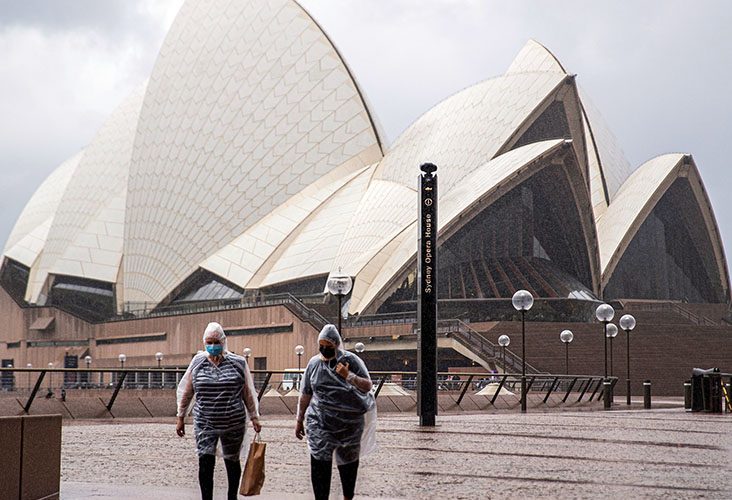Is the ‘super cold’ a new post-lockdown phenomenon?

- As Australians relax COVID-19 safety measures, a “super cold” is sweeping the nation.
- Since COVID-19 can manifest much in the same way as a cold, the new illness is causing confusion and raising fears of SARS-CoV-2 infections.
- Experts believe the phenomenon is the result of first encounters between new viruses and immune systems re-entering the world after isolation.
The symptoms are disturbingly familiar, and it has Australians on edge. But it is not COVID-19. It is just a common cold virus, or maybe a string of them racing through the local population. Some are thinking of it, or them, as Australia’s “super cold.”
Experts suspect the super cold’s stunning spread is due to the collision of immune systems that have been in a nearly 2-year period of isolation overwhelmed by a host of new germs all at once.
Associate Professor Dr. Ian Mackay of the University of Queensland, Australia told Medical News Today:
“Some of what we may feel are ‘super colds’ might just be normal colds that we’ve simply forgotten to recognize because Australia had successfully kept them at bay during the pandemic.”
A similar super cold effect was reported in November of last year in the U.K. as residents first ventured out from lockdown.
“Without some studies,” noted Dr. Mackay, “I’m presuming these are just everyday acute respiratory tract illnesses, caused by a range of different endemic viruses. And to be clear, when I say ‘endemic,’ I mean viruses that are always with us in some numbers; a baseline of infections that tick along.”
Similar “super cold” phenomena are likely to occur across the globe as COVID-19 safety measures are relaxed.
Definitely sick, but with what?
The symptoms people are experiencing are classic signs of an upper respiratory tract infection: runny nose, sore throat, and sticky eyes.
A dry cough may also occur, and recovery is usually within 5 to 7 days, Sydney-based Dr. Charlotte Hespe, MD, told the Daily Mail.
Some people are also experiencing flu symptoms such as fever, headache, and body aches.
These symptoms sound a lot like those of COVID-19, although COVID-19 has a few symptoms that do not accompany a cold or a flu, such as a loss of taste or smell.
The safest strategy is to take a COVID-19 test if you experience such symptoms.
A regular influenza, typically lasting 10–15 days, is more unpleasant and can be dangerous even when it is not COVID-19. Experts recommend getting available flu shots as a way to help out one’s immune system as it re-enters the world.
Experts also encourage people to remain current with COVID-19 vaccinations and boosters.
Flu season
The rapid proliferation of the super cold and influenzas in Australia is seen as evidence that this year’s flu season may be difficult.
Said Dr. Mackay:
“Flu may not have a big season this year, or it may. But we know it is circulating elsewhere in the world, and with travel open, I expect it will arrive, and we’ll see a very fast-moving spread of influenza.”
“We’ll see,” speculated Dr. Mackay, “the full spectrum of outcomes from asymptomatic infections, to mild and moderate flu-like illnesses with fever, muscle aches, tiredness, and breathing issues. But we’ll also see our already busy hospitals stressed further by flu as some severe disease includes stresses on the lungs, heart, and brain.”
“Serious flu impacts the very young (the highest proportion) and the elderly. We will also see deaths, but we have traditionally been bad at accurately capturing those due to flu,” according to Dr. Mackay. “Without laboratory testing to define which virus we have, we’ll be guessing as to whether these are due to the current pandemic virus or flu or another one of 200 acute respiratory viruses.”
Fighting fatigue
Another issue is “vaccine fatigue,” with many feeling they have had enough shots. Likewise, many are tired of mask-wearing and social distancing.
Fatigue notwithstanding, however, Dr. Mackay prescribed sensible behavior in the face of super colds, the flu, and COVID-19. He said we should do “the exact same things we have seen recommended for SARS-CoV-2 — our current pandemic pathogen.”
“Wash your hands (a really good general rule for keeping viruses and bacteria from infecting us); wear a mask because it’s smarter to assume these are all airborne viruses that we exhale on our breath.”
“And,” said Dr. Mackay, “meet outdoors, at least until business and leaders get serious about cleaning the air in indoor airspaces the way we expect our water and food to be free of disease-causing viruses. Indoor settings can use highly efficient filters, UV built into the [air conditioners] or a higher number of room air changes per minute.”
“Until we start to care about the air, we’re going to have to look after ourselves and keep ourselves healthy.”
Source: Read Full Article
